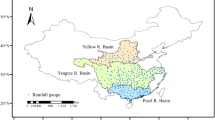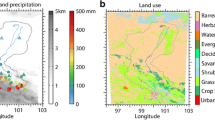Abstract
Many impact studies require climate change information at a finer resolution than that provided by general circulation models (GCMs). Therefore the outputs from GCMs have to be downscaled to obtain the finer resolution climate change scenarios. In this study, an automated statistical downscaling (ASD) regression-based approach is proposed for predicting the daily precipitation of 138 main meteorological stations in the Yangtze River basin for 2010–2099 by statistical downscaling of the outputs of general circulation model (HadCM3) under A2 and B2 scenarios. After that, the spatial–temporal changes of the amount and the extremes of predicted precipitation in the Yangtze River basin are investigated by Mann–Kendall trend test and spatial interpolation. The results showed that: (1) the amount and the change pattern of precipitation could be reasonably simulated by ASD; (2) the predicted annual precipitation will decrease in all sub-catchments during 2020s, while increase in all sub-catchments of the Yangtze River Basin during 2050s and during 2080s, respectively, under A2 scenario. However, they have mix-trend in each sub-catchment of Yangtze River basin during 2020s, but increase in all sub-catchments during 2050s and 2080s, except for Hanjiang River region during 2080s, as far as B2 scenario is concerned; and (3) the significant increasing trend of the precipitation intensity and maximum precipitation are mainly occurred in the northwest upper part and the middle part of the Yangtze River basin for the whole year and summer under both climate change scenarios and the middle of 2040–2060 can be regarded as the starting point for pattern change of precipitation maxima.











Similar content being viewed by others
References
Arora M, Goel NK, Singh P (2005) Evalution of temperature trends over India. J Hydrol Sci 50(1):81–93
Aziz OIA, Burn DH (2006) Trends and variability in the hydrological regime of the Mackenzie River Basin. J Hydrol 319(1–4):282–294
Bate BC, Kundzewicz ZW, Wu S, Palutikof J (eds) (2008) Climate change and water. Technical paper of the Intergovernmental panel on climate change. IPCC Secretariat, Geneva, pp 15–18
Burn DH, Elnur MAH (2002) Detection of hydrologic trends and variability. J Hydrol 255:107–122
Chen H, Guo SL, Xu C-Y, Singh VP (2007) Historical temporal trends of hydro-climatic variables and runoff response to climate variability and their relevance in water resource management in the Hanjiang basin. J Hydrol 344:171–184
Chen H, Guo J, Xiong W, Guo S-L, Xu C-Y (2010) Downscaling GCMs using the Smooth Support Vector Machine method to predict daily precipitation in the Hanjiang Basin. Adv Atmos Sci 27(2):274–284
Chu JT, Xia J, Xu C-Y, Singh VP (2010) Statistical downscaling of daily mean temperature, pan evaporation and precipitation for climate change scenarios in Haihe River of China. Theor Appl Climatol 99:149–161
Dibike YB, Coulibaly P (2005) Hydrologic impact of climate change in the Saguenay watershed: comparison of downscaling methods and hydrologic models. J Hydrol 307:145–163
Fowler HJ, Blenkinsopa S, Tebaldib C (2007) Linking climate change modelling to impacts studies: recent advances in downscaling techniques for hydrological modelling. Int J Climatol 27:1547–1578
Ghosh S, Mujumdar PP (2008) Statistical downscaling of GCM simulations to streamflow using relevance vector machine. Adv Water Resour 31(1):132–146
Gregory JM, Wigley TML, Jones PD (1993) Application of Markov models to area-average daily precipitation series and interannual variability in seasonal totals. Clim Dyn 8:299–310
Harpham C, Wilby RL (2005) Multi-site downscaling of heavy daily precipitation occurrence and amounts. J Hydrol 312:235–255
Hessami M, Gachon P, Ouarda T, St-Hilaire A (2008) Automated regression-based Statistical Downscaling Tool. Environ Model Softw 23:813–834
Hoerl AE, Kennard RW (1970) Ridge regression: application to nonorthogonal problems. Technometrics 12:69–82
Huang J, Zhang J, Zhang ZX, Xu C-Y, Wang B, Yao J (2010) Estimation of future precipitation change in the Yangtze River basin by using statistical downscaling method. Stoch Environ Res Risk Assess. doi:10.1007/s00477-010-0441-9
Huth R (2002) Statistical downscaling of daily temperature in Central Europe. J Clim 15:1731–1742
IPCC (2007) Climate change 2007: Synthesis Report Forth Assessment Report of the Intergovernmental panel on climate change, Geneva, Switzerland
Kendall MG (1975) Rank correlation methods. Griffin, London
Khan MS, Coulibaly P, Dibike Y (2006) Uncertainty analysis of statistical downscaling methods. J Hydrol 319:357–382
Mann HB (1945) Non-parametric test against trend. Econometrica 13:245–259
Maraun D, Wetterhall F, Ireson AM, Chandler RE, Kendon EJ, Widmann M, Brienen S Rust HW, Sauter T, Themeßl M, Venema VKC, Chun KP, Goodess CM, Jones RG, Onof C, Vrac M Thiele-Eic I (2010) Precipitation downscaling under climate change: recent developments to bridge the gap between dynamical models and the end user. Rev Geophys. doi:10.1029/2009RG000314
McCuen RH (2003) Modeling hydrologic change. CRC Press, Boca Raton, pp 261–263
Srikanthan R, McMahon TA (2001) Stochastic generation of annual, monthly and daily climate data: a review. Hydrol Earth Syst Sci 5(4):653–670
Su BD, Jiang T, Shi YF, Becker S, Gemmer M (2004) Observed precipitation trends in the Yangtze catchment from 1951 to 2002. J Geogr Sci 2(14):204–218
Su BD, Xiao B, Zhu DM, Jiang T (2005) Trends in frequency of precipitation extremes in the Yangtze River basin, China: 1960–2003. J Hydrol Sci 50(3):479–492
Su BD, Kundzewicz ZW, Jiang T (2009) Simulation of extreme precipitation over the Yangtze River Basin using Wakeby distribution. Theor Appl Climatol 96:209–219
Tripathi S, Srinivas VV, Nanjundiah RS (2006) Downscaling of precipitation for climate change scenarios: a support vector machine approach. J Hydrol 330(3–4):621–640
Wetterhall F, Halldin S, Xu C-Y (2005) Statistical precipitation downscaling in Central Sweden with the analogue method. J Hydrol 306:174–190
Wilby RL (1998) Statistical downscaling of daily precipitation using daily airflow and seasonal teleconnection indices. Clim Res 10:163–178
Wilby RL, Wigley TML (2000) Precipitation predictors for downscaling: observed and general circulation model relationships. Int J Climatol 20:641–661
Wilby RL, Hay LE, Leavesley GH (1999) A comparison of downscaled and raw GCM output: implications for climate change scenarios in the San Juan River basin, Colorado. J Hydrol 225(1–2):67–91
Wilby RL, Dawson CW, Barrow EM (2002) SDSM—a decision support tool for the assessment of regional climate change impacts. Environ Model Softw 17:147–159
Wilby RL, Charles SP, Zorita E, Timbal B, Whetton P, Mearns LO (2004) The guidelines for use of climate scenarios developed from statistical downscaling methods. Supporting material of the Intergovernmental Panel on Climate Change (IPCC), prepared on behalf of Task Group on Data and Scenario Support for Impacts and Climate Analysis (TGICA). http://ipcc-ddc.cru.uea.ac.uk/guidelines/StatDown_Guide.pdf
Wilby RL, Beven KJ, Reynolds N (2008) Climate change and fluvial flood risk in the UK: more of the same? Hydrol Process 22(14):2511–2523
Wilks DS (1989) Conditioning stochastic daily precipitation models on total monthly precipitation. Water Resour Res 25:1429–1439
Xu C-Y (1999) From GCMs to river flow: a review of downscaling methods and hydrologic modelling approaches. Prog Phys Geogr 23:229–249
Xu C-Y, Gong LB, Jiang T, Chen DL (2006) Analysis of spatial distribution and temporal trend of reference evapotranspiration and pan evaporation in Changjiang (Yangtze River) catchment. J Hydrol 327:81–93
Xu Y, Xu C, Gao X, Luo Y (2009) Projected changes in temperature and precipitation extremes over the Yangtze River Basin of China in the 21st century. Quat Int 208:44–52
Yang G, Weng L, Li L (2007) Yangtze Conservation and Development Report 2007. Science Press, Beijing
Yue S, Pilon P, Cavadias G (2002) Power of the Mann–Kendall test and the Spearman’s rho test for detecting monotonic trends in hydrological time series. J Hydrol 259:254–271
Zetterqvist L (1991) Statistical estimation and interpretation of trends in water quality time series. Water Resour Res 27(7):1637–1648
Zhang Q, Jiang T, Gemmer M, Becker S (2005) Precipitation, temperature and discharge analysis from 1951 to 2002 in the Yangtze Catchment, China. J Hydrol Sci 50(1):65–80
Zhang Q, Liu C-L, Xu C-Y, Xu YP, Jiang T (2006) Observed trends of annual maximum water level and streamflow during past 130 years in the Yangtze River basin, China. J Hydrol 324:255–265
Zhang Q, Xu C-Y, Zhang ZX, Chen DY, Liu C-L, Lin H (2008) Spatial and temporal variability of precipitation maxima during 1960–2005 in the Yangtze River basin and possible association with large-scale circulation. J Hydrol 353:215–227
Acknowledgments
The study is financially supported by the National Program on Key Basic Research Project (973 Program) (2010CB428405) and National Natural Science Fund of China (50809049). The authors are greatly appreciated the Canadian Climate Change Scenarios Network (CCCSN) for providing the downscaling tool (ASD) and the reanalysis products of the NCEP and HadCM3 outputs for the downscaling tool. The authors also thank the National Climate Centre of China for supplying the daily precipitation data of meteorological stations in the Yangtze River Basin.
Author information
Authors and Affiliations
Corresponding author
Rights and permissions
About this article
Cite this article
Guo, J., Chen, H., Xu, CY. et al. Prediction of variability of precipitation in the Yangtze River Basin under the climate change conditions based on automated statistical downscaling. Stoch Environ Res Risk Assess 26, 157–176 (2012). https://doi.org/10.1007/s00477-011-0464-x
Published:
Issue Date:
DOI: https://doi.org/10.1007/s00477-011-0464-x




